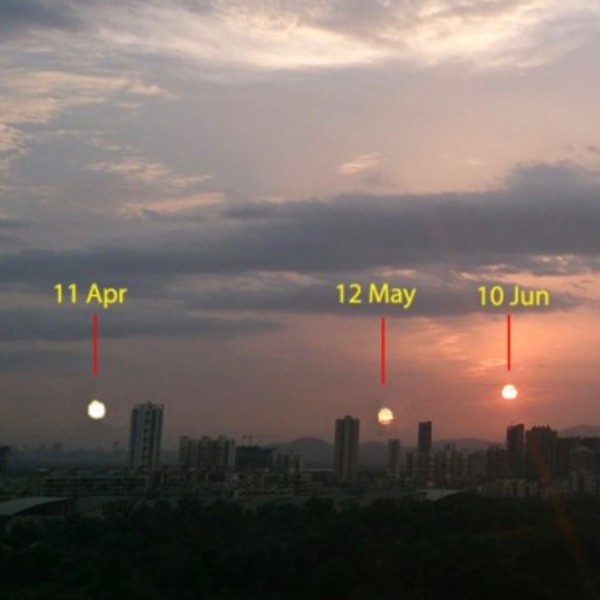

Manhattanhenge. This is a 3-image composite to preserve the disk of the sun and also shadow details of the surroundings. Gowrishankar Lakshminarayanan was in Gantry Plaza State Park, Queens, New York looking straight through 42nd Street, with the Chrysler building to the right. Canon 5D Mark III, Canon EF 70-200 F2.8 USM L Lens
Exp: ISO 100, F8.0, 1/500s/1/1000s/1/250s. HDR composite.
Every year around May 29 and 30 – and again for a day or two around July 12 – people in New York City look forward to Manhattanhenge. EarthSky community member Gowrishankar Lakshminarayanan wrote:
Manhattanhenge is a phenomenon where the sun set aligns perfectly with the streets of Manhattan, more importantly along 42nd, 34th and 14th Streets. It happens twice every year – around the end of May and early July. May 29th and 30th are the most talked-about dates in media.
As Gowri says, note that you don’t have to look on the precise dates of May 29 and 30. In fact, he captured the image above on June 1, 2017.
The phenomenon of Manhattanhenge isn’t mysterious, of course. Similar alignments occur around the world, on various dates. Think Stonehenge. The point of sunset along the horizon varies throughout the year. At this time of year – between the March equinox and June solstice – the sunset point is shifting northward each day on the horizon, as seen from around the globe. It’s the northward-shifting path of the sun that gives us summer in the Northern Hemisphere and winter in the Southern Hemisphere.

Abhijit Juvekar in Dombivli, India created this composite image of sunsets over a period of months, to show that the sun sets progressively farther north in the months leading up to the June solstice. Thank you, Abhijit!
The June solstice will bring the sun’s northernmost point in our sky – and northernmost sunset – and afterwards the sun’s path in our sky, and the sunset point, both will start shifting southward again. As for the sun’s alignment with the city of New York, and the streets of Manhattan Island, Scientific American explained:
The phenomenon is based on a design for Manhattan outlined in The Commissioners’ Plan of 1811 for a rectilinear grid, or ‘gridiron’ of straight streets and avenues that intersect one another at right angles. This design runs from north of Houston Street in Lower Manhattan to just south of 155th Street in Upper Manhattan. Most cross streets in between were arranged in a regular right-angled grid that was tilted 29 degrees east of true north to roughly replicate the angle of the island of Manhattan.
And because of this 29-degree tilt in the grid, the magic moment of the setting sun aligning with Manhattan’s cross streets does not coincide with the June solstice but rather with specific dates in late May and early July.
Read more about Manhattanhenge from ScientificAmerican.com
Bottom line:
from EarthSky https://ift.tt/2L7ot2u


Manhattanhenge. This is a 3-image composite to preserve the disk of the sun and also shadow details of the surroundings. Gowrishankar Lakshminarayanan was in Gantry Plaza State Park, Queens, New York looking straight through 42nd Street, with the Chrysler building to the right. Canon 5D Mark III, Canon EF 70-200 F2.8 USM L Lens
Exp: ISO 100, F8.0, 1/500s/1/1000s/1/250s. HDR composite.
Every year around May 29 and 30 – and again for a day or two around July 12 – people in New York City look forward to Manhattanhenge. EarthSky community member Gowrishankar Lakshminarayanan wrote:
Manhattanhenge is a phenomenon where the sun set aligns perfectly with the streets of Manhattan, more importantly along 42nd, 34th and 14th Streets. It happens twice every year – around the end of May and early July. May 29th and 30th are the most talked-about dates in media.
As Gowri says, note that you don’t have to look on the precise dates of May 29 and 30. In fact, he captured the image above on June 1, 2017.
The phenomenon of Manhattanhenge isn’t mysterious, of course. Similar alignments occur around the world, on various dates. Think Stonehenge. The point of sunset along the horizon varies throughout the year. At this time of year – between the March equinox and June solstice – the sunset point is shifting northward each day on the horizon, as seen from around the globe. It’s the northward-shifting path of the sun that gives us summer in the Northern Hemisphere and winter in the Southern Hemisphere.

Abhijit Juvekar in Dombivli, India created this composite image of sunsets over a period of months, to show that the sun sets progressively farther north in the months leading up to the June solstice. Thank you, Abhijit!
The June solstice will bring the sun’s northernmost point in our sky – and northernmost sunset – and afterwards the sun’s path in our sky, and the sunset point, both will start shifting southward again. As for the sun’s alignment with the city of New York, and the streets of Manhattan Island, Scientific American explained:
The phenomenon is based on a design for Manhattan outlined in The Commissioners’ Plan of 1811 for a rectilinear grid, or ‘gridiron’ of straight streets and avenues that intersect one another at right angles. This design runs from north of Houston Street in Lower Manhattan to just south of 155th Street in Upper Manhattan. Most cross streets in between were arranged in a regular right-angled grid that was tilted 29 degrees east of true north to roughly replicate the angle of the island of Manhattan.
And because of this 29-degree tilt in the grid, the magic moment of the setting sun aligning with Manhattan’s cross streets does not coincide with the June solstice but rather with specific dates in late May and early July.
Read more about Manhattanhenge from ScientificAmerican.com
Bottom line:
from EarthSky https://ift.tt/2L7ot2u

Aucun commentaire:
Enregistrer un commentaire